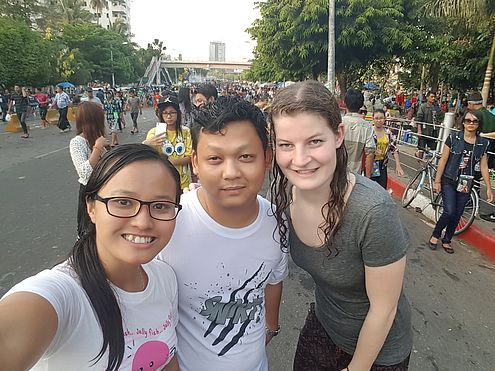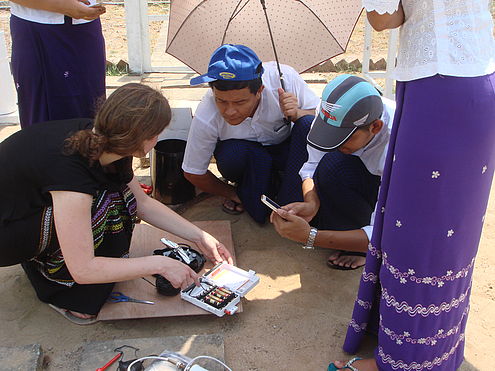Innovative rainfall measurement devices in tropical regions. A comparative data analysis for Yangon and Bago, Myanmar
A comparative data analysis for Yangon and Bago, Myanmar
Due to the fact that Myanmar is a rapidly developing country, a good understanding of the precipitation systems is becoming increasingly important. Last year the opportunity to do my Bachelor Thesis in Myanmar arose. Performing water related studies abroad has piqued my interest since the start of my bachelor. During the monsoon period there are regular floods in Myanmar. To address this problem, it is necessary to study the hydrological cycle. In my research, I studied the rain which is very important for designing a proper sewer system. The main focus of my Bachelor Thesis was comparing the measurement results of different rain devices. Furthermore, satellite precipitation measurements were compared to ground based disdrometer measurements.
When I arrived in Myanmar, the country was celebrating Thingyan. This is the Burmese New year, which ends in a five-day water festival. On every street in Yangon people were partying and buckets were continuously filled with water. These buckets were subsequently emptied above everyone that joined these festivities. I was not spared of course, seeing a foreigner was a reason to even increase the rate at which buckets were filled and emptied. In the city centre a large waterfestival was organized. Water was being pumped out of Inya Lake and was used to spray dancing visitors using a large garden hose. I came to Myanmar to assess the rain intensities in this country, but this extreme amount of human induced precipitation was not something I expected to happen the first day of my arrival. After the water festival, I was less lucky with the amount of precipitation however, the rainy season started extremely late this year.
After processing the first cultural shocks it was time to start with my research. Three types of precipitating measurement devices had to be installed at the Yangon Technical University (YTU) in Yangon and at the Irrigration Technology Centre (ITC) in Bago. Installing these devices should be a relatively simple task, but I have experienced that even the smallest things can result in very long delays in Myanmar. After writing various letters and having multiple conversations at both institutes, the tipping buckets, Delft-disdrometer and the manual rain gauges were placed.
Results showed that rain intensities of the tipping bucket and the manual rain gauges corresponded quite well, while the Delft-disdrometer results were very different. This indicated that the calibration of the Delft-disdrometer was not performed correctly. Recalibration was therefore performed using tipping bucket rain intensity results.
Rain forecasts in Myanmar are currently limited to the amount of showers per day in a large area. The desire to improve the temporal and spatial resolution of these forecasts is understandable. It is however, quite challenging to improve the quality in a developing country such as Myanmar. The use of satellite imagery could provide a cheap solution to improve the rain forecasting system in Myanmar. The results of Global Precipitation Measurement results was therefore compared to two disdrometers; the Delft-disdrometer and the Thies LPM. The dropsize distribution and the rain intensity were the two main parameters for comparing results of these three devices.
Firstly, theoretical dropsize distributions were compared to measurement results of the GPM and the two disdrometers. Both the GPM and the Thies LPM resulted directly in a theoretically correct dropsize distribution (DSD). A theoretically sound DSD was also obtained with the results of the Delft-disdrometer. In order to obtain this DSD an additional step had to be performed, due to the fact that the Delft-disdrometer is not capable of measuring droplets smaller than 1 mm.
Secondly, it was concluded that the DSD of the GPM was very similar to measurements of the Thies LPM, in contraty to the measured rain intensity. Unfortunately it was not possible to compare Delft-disdrometer measurements to GPM data due to the lack of simultaneous occurrences of rain events and GPM flyover.

